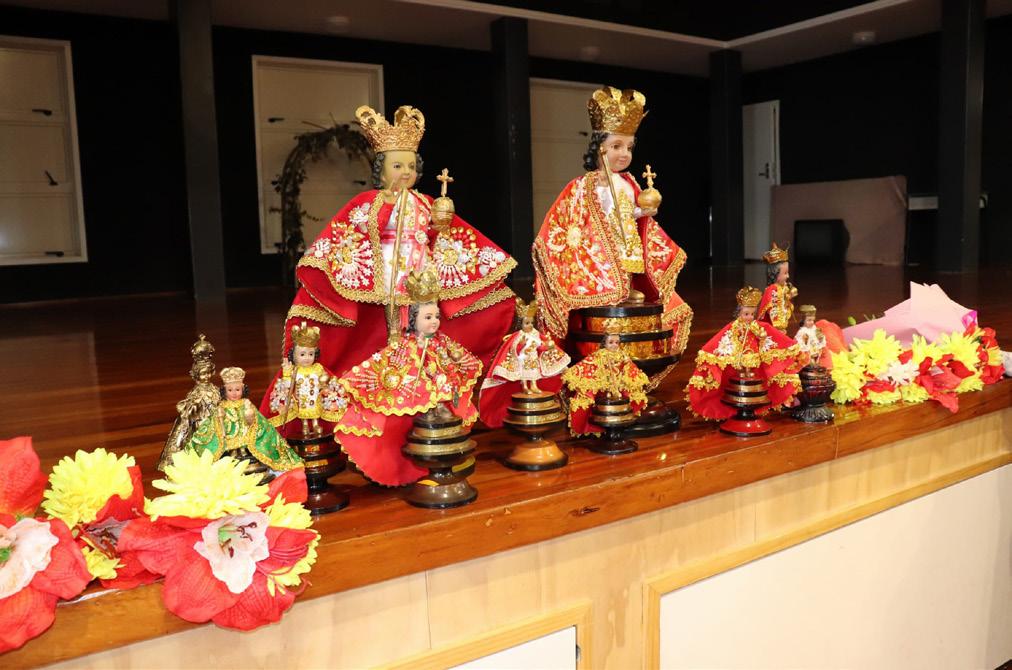
2 minute read
VIVA PIT SEÑOR
“VIVA PIT SEÑOR!” “VIVA SEÑOR SANTO NIÑO!”
BRIGID CONROY
Advertisement
Jubilant cheers of praise fill the air each year as faithful gather to conclude the annual novena to the Holy Child Jesus, the Santo Niño.
Readers may be wondering what this devotion is all about. Representatives from the Hamilton Santo Niño working committee (Mel Libre and Dexter Soon, both born in Cebu, Philippines, and Ruth Bailey) kindly share what happens locally and where this devotion originated:
WHAT IS THE SANTO NIÑO (OR STO NIÑO) NOVENA?

The Santo Niño novena is the practice of praying to the Holy Child leading up to the feast day on the third Sunday of January. (The Hamilton Santo Niño devotees observe this on the first Saturday of January.)
WHY DO PEOPLE COME TOGETHER TO PRAY THE NOVENA?
Devotees seek help from the Holy Child and express their thanksgiving for blessings granted to them.
WHAT HAPPENS AT THE NOVENA? HOW MANY PEOPLE PARTICIPATE?
Each evening begins with the novena prayers followed by Mass. In Hamilton a different priest each evening was invited to be the main celebrant. After the recessional hymn, devotional dance is offered and food is shared. This year about 100 people came together each day to pray the novena in Hamilton at St Matthew’s, Silverdale.
To culminate the novena, on January 16, we celebrated with Mass at the Cathedral of the Blessed Virgin Mary, with Fr Fernando Alombro, Filipino chaplain, as celebrant. After the Mass there was a procession from the church to the Gerry Sullivan Events Centre for a fiesta full of food, dancing of the Sinulog (the devotional dance to Santo Niño) and other cultural dances. Attendees numbered 300-400 people.
Also part of the celebrations, many children dress up in the Santo Niño attire, much to the joy of their parents and other attendees.
WHERE DID THE DEVOTION ORIGINATE?
It started in Cebu, Philippines where the image of Santo Niño is venerated. The image of the Holy Child Jesus was a gift given to Queen Juana of Cebu by Ferdinand Magellan after her conversion to Christianity on April 15, 1521. When Magellan was killed by the neighbouring king, Lapulapu, the Spaniards left and continued their voyage to achieve the first circumnavigation of the world. Another expedition in 1565 led by Miguel Legazpi was not welcomed by the king, and they attacked and burned Cebu. In the ashes, soldiers found the image of the Santo Niño undamaged.
From there on, through the centuries, devotees have sought assistance from the Holy Child Jesus. Today, the celebrations comprise as many as 2-3 million in the grand finale called Sinulog.
HOW LONG HAS THE DEVOTION BEEN IN HAMILTON AND IN NEW ZEALAND?
It started in 2013 in Hamilton. Most of the places with large Bisaya-speaking communities hold novenas, Masses and feasts. The Auckland community has celebrated the devotion for more than 25 years and gathers as many as 5,000 people on the final feast day.
Photos provided by Ruth Bailey











